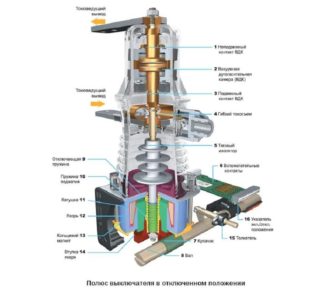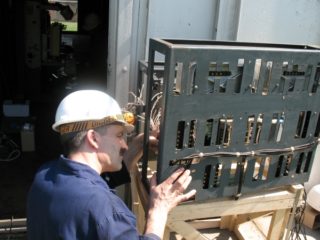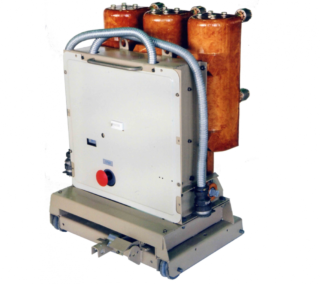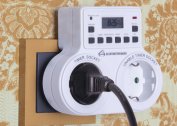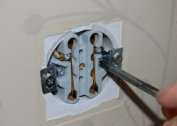For the design of taps from high-voltage transmission lines, special switching devices are traditionally used. Their common name is the vacuum circuit breaker, which is explained by the features of the arcing chamber. It is possible to get acquainted with these devices in detail only after studying the background of their appearance.
History reference
For the first time, vacuum circuit breakers were mentioned in the early 30s of the XX century, when the devices were used to disconnect relatively low-current circuits operating under voltage up to 40 kV. To obtain reliable vacuum dampers that can turn off significant currents in circuits at high potential, a whole series of studies was required. During their implementation, approximately by 1957, the processes observed during high-voltage arc burning were completely studied and systematized. The transition from prototypes produced in single copies to the mass production of modern devices took another two long decades.
Operating principle
The principle of arc extinction is based on the fact of high dielectric strength and special insulating properties of vacuum obtained artificially from physics. When the power contactors are opened in the chamber where they are placed, an electric arc is formed, supported by metal particles evaporating from their surface. The absence of conditions for its stabilization prevents the development of a process peak due to the high dielectric properties of the vacuum medium.
Due to the significant dielectric strength of the vacuum, the moment of quenching of the arc is shifted to a point preceding the maximum of its development. In electrical engineering, this phenomenon is called a “current cutoff”. Its presence negatively affects electrical networks, since the result of this process is switching overvoltage.
Features of application and operation
 By its design, at the initial stage, this type of circuit breaker was developed as a device intended for installation in switchgear cabinets (in complex devices). Currently, they are mounted in open distribution structures (outdoor switchgear). A modern vacuum circuit breaker is a high-speed switching device designed for long service life in comparison with its predecessors, which have oil and gas environments.
By its design, at the initial stage, this type of circuit breaker was developed as a device intended for installation in switchgear cabinets (in complex devices). Currently, they are mounted in open distribution structures (outdoor switchgear). A modern vacuum circuit breaker is a high-speed switching device designed for long service life in comparison with its predecessors, which have oil and gas environments.
Most modern energy farms have abandoned obsolete designs and finally switched to fairly compact and maintenance-free new circuit breakers. This is due to the following reasons:
- the vacuum device is unpretentious and does not need regular cleaning of contacts or updating the environment;
- during operation of the oil device, the filler constantly leaks;
- according to the passport, the life of the vacuum devices reaches 20 years, which is much higher than the same indicator for other types of circuit breakers.
During operation, the drive mechanism often fails at the most inopportune moment for this. To maintain it in working condition, the device has a special unit for manual spring charging. Mandatory for these devices is the presence of an emergency button that allows you to disable the locking mechanism for rolling out the switchgear modules when the cabinet is on. This point concerns the safety of personnel servicing equipment and requires close attention.
Design Features
Each model of a high-voltage vacuum switch has individual characteristics, as it is intended for operation in networks with various electrical indicators. In addition, manufacturers also make some adjustments to the design of their products. However, in general, the composition of the components of these devices remains unchanged. Main elements:
- A housing made on the basis of durable metal, inside of which an on and off drive is mounted (it can be spring or another type).
- 3-pole current collector, designed to connect to the 380 Volt network and disconnected when the switchgear is switched from the operating mode to the deflated position.
- The cart for placement inside the case, in its design different from other similar structures.
The electrical part of the product has special partitions that separate the phase sections from one another. It also has a complex device and contains a number of elements described in the passport.
Varieties of vacuum circuit breakers
Products are usually classified according to the class of potential switched by them.
Among the variety, the following types stand out:
- Devices for working with voltages of 6-10 kV.
- Devices for switching higher levels - up to 35 kV.
- Devices designed for ultra-high voltage 110-220 kV.
Another “working” criterion for the classification of circuit breakers is the power that they can transfer to the load. According to this parameter, their division is carried out similarly to the classification of the consumer.
Advantages and disadvantages
The advantages of the devices include:
- small dimensions;
- the ability to quickly replace individual sections;
- noiselessness and independence from orientation in space;
- safety for the health of staff.
They do not need to replenish the protective environment and are highly reliable. But these products could not do without the problems inherent in many electrical devices. The disadvantages of vacuum circuit breakers include:
- limited working currents;
- "Tendency" to overvoltage;
- small switching resource.
Despite the existing shortcomings, these devices have firmly taken their place in the list of the most modern switching equipment for explosives.
Features of selection and installation
In the process of selecting a switch, the following important points are taken into account:
- the protective characteristics of the device must correspond to the parameters of the network in which it is supposed to operate;
- the switch is selected based on the most difficult operating conditions;
- rated current and voltage must exceed the corresponding parameters for the protected network;
- the breaking current must not exceed the value guaranteed by the manufacturer.
Before installing the vacuum circuit breaker, it is necessary to carefully examine the installation site and make sure that there are no damages or defects. Then you need to clean the isolated surfaces of the poles with a dry rag.
It is not allowed to install new equipment in a system on the insulating surfaces of which there are chips, cracks and severely deformed sections.
The secondary circuit diagram with the subsequent connection of the ground bus is subject to mandatory verification. The vacuum circuit breaker itself is attached directly to the moving part of the trolley with the help of special bolted hardware.
The most common models
Among the most common models of vacuum chambers, the following stand out:
- VVE-M-10–20.
- VVE-M-10–40.
- VVTE-M-10–20.
Almost all product samples from this list are a further development of old oil circuit breakers and are able to operate in AC and DC circuits. Installation, subsequent configuration and commissioning of high-voltage vacuum devices are labor-intensive procedures that determine their further functionality. Therefore, the listed operations are trusted only to specialists with the appropriate qualifications.
When installing the device, the setup sequence must be followed. Compliance with this requirement is the basis for the safety of operating personnel or an on-duty electrician authorized to work with high-voltage equipment.
Products belonging to the category of vacuum circuit breakers need professional selection and evaluation, since their operation is associated with high voltages.

